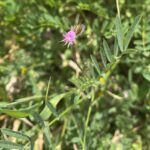Ονοβρυχίδα η ισόδοντη
Etymology of Onobrychis aequidentata: The name of the genus, "Onobrychis", is Ancient Greek, "ὀνοβρυχίς" [onovrychis], and derives from "ὀνος" [onos], meaning "donkey" and "βρυχίς" [vrychis], meaning "feast, symposium" because according to the ancient Greeks, the donkeys were having a feast devouring Onobrychises. Latin "aequidentata'' comes from "aequus", meaning "even" and "dentata", meaning "toothed", hence "even toothed", referring to the (supposedly - not a general rule for the) even height of its fruits' spikes.
There are four Onobrychis taxa in the wild Cypriot habitat.
Onobrychis aequidentata is a neither common nor a rare plant in Cyprus. It exists in central-southern, north-eastern, central-northern, and north-eastern Cyprus, at an altitude between 100-875 metres. It primarily grows on rocky hillsides and open pine forests. The specimen in the picture originates from a rocky, unfertile ground of Trozena village (Limassol district). Its flowering period is from March until May.
How to identify Onobrychis aequidentata:
It has similar/same flowers to Onobrychis caput-galli and crista-galli, but it differs from them primarily due to its peduncles that are generally higher or much higher than subtending leaves, something that is the opposite of the other two species.
